Application of PM Fiber
Because of the function of maintaining the polarization state of light (e.g.,【Picture 1】), the applications of PM fibers cover a variety of fields such as communications, medicine, sensing, and military, etc. In addition to typical deflectors, coherent communications, and hydrophones, some other applications of PM fibers will be introduced here.

【Picture 1】Structure of a deskewer using two sections of PM fiber fused at 45°
Application 1:Fiber Optic Gyro
One of the typical applications of PM fibers is the fabrication of sensing fiber rings in fiber optic gyros, as in【Picture 2】.

【Picture 2】The application of PM fiber in fiber optic gyroscope
Fiber optic gyroscope is an interferometer-type angular velocity measurement device based on the Sagnac effect and composed of a bias-preserving fiber optic ring. When the fiber optic gyro is stationary, the light emitted from the light source is divided into two beams of light propagating in opposite directions through the Y waveguide, and the two beams of light are transmitted through the fiber optic ring and return to the Y waveguide at the same time; when the fiber optic gyro rotates relative to the inertial space, the fiber optic ring rotates, and the two beams of light propagating in the opposite direction return to the Y waveguide at a different time, and the two beams of light produce an optical range difference, which is directly proportional to the angular velocity of the fiber optic gyro rotation, and can measure the change in angular velocity by detecting the optical range difference. By detecting the optical range difference, the change in angular velocity can be measured.
Fiber optic ring is a ring-shaped optical path device with a diameter of a few millimeters to several thousand millimeters made by winding PM optical fiber in a certain way. The bias-preserving optical fiber is a single linear arrangement before forming a ring, which does not constitute a sensitive optical path and cannot be sensitive to the angular velocity signal, and it can only be formed into a sensitive optical path to form a Sagnac interferometer under a certain lawful arrangement of a special winding method.
Fiber optic gyroscope is widely used in weaponry, which has high requirements on the symmetry, length, volume, optical transmission and environmental adaptability of the fiber optic ring as the core sensitive device.
Application 2:Optical Fiber Laser
PM fibers are widely used in fiber lasers due to their special polarization characteristics. PM fibers for lasers can be divided into ytterbium-doped, thulium-doped, erbium-ytterbium co-doped and PM fibers, ytterbium-doped and bias preserving photonic crystals with large mode-field area, and passively matched bias preserving fibers according to the difference of their dopant materials.
Fiber laser with double-clad ytterbium-doped fiber as the gain medium has high output power, high slope efficiency and other characteristics, and has a wide range of applications in the military and other fields; thulium-doped fiber bias-preserving is a high-power narrow linewidth fiber amplifier applications for human eye safety, with high slope efficiency, high absorption coefficient, high polarization extinction ratio and other characteristics, widely used in narrow linewidth fiber amplification, military radar, plastics processing, medical beauty, Surgery and other fields; Erbium-Ytterbium co-doped polarization preserving fibers are mainly used in 1.5 μm polarization preserving optical amplifiers, LIDAR, human eye safety laser products, which can reduce the required pump power and fiber length, thereby reducing the impact of nonlinear effects. Ytterbium-doped polarization-preserving photonic crystal fibers with large mode field area can effectively relieve the gain pressure of the subsequent system of high-power fiber lasers, and at the same time, improve the integration, reliability and availability of the system, which can achieve a high extinction ratio of the pulse and a high beam quality output, thus effectively suppressing the amplitude-frequency effect due to the dispersion of polarized modes and intermodal interference in the process of fiber amplification of high-pulse energy, which is widely used in ultra-high-power lasers and femtosecond lasers. It is widely used in ultra-high power lasers and femtosecond lasers.
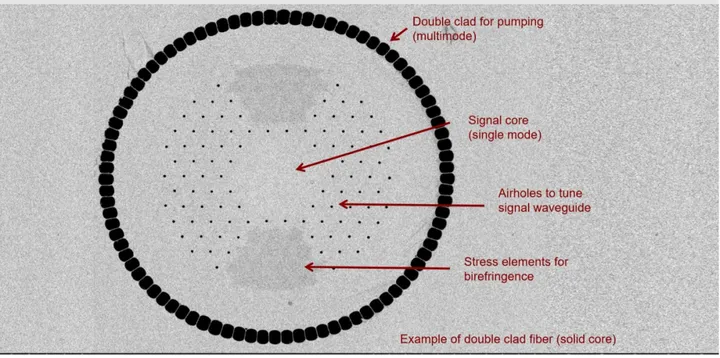
【Picture 3】 Ytterbium-doped, bias-preserving fibers and NKT’s large-mode-field-area ytterbium-doped, bias-preserving photonic crystal fibers that can be used in fiber lasers
Application 3: Voltage Transformer(FOCT)
Similar to the fiber optic gyro, PM fiber in the current transformer application, also constitute the sensing fiber optic ring. However, the difference between the two is that the sensing fiber ring here can be composed of rotating PM fibers, and the whole system makes use of the Faraday magneto-optical effect, i.e., the magnetic field generated by the current-carrying conductor will rotate the polarization state of the transmitted light in the fiber ring, as shown in [Picture 4]. Since the current in the current-carrying conductor is proportional to the generated magnetic field, the current can be calculated by monitoring the polarization rotation angle of the light accordingly.
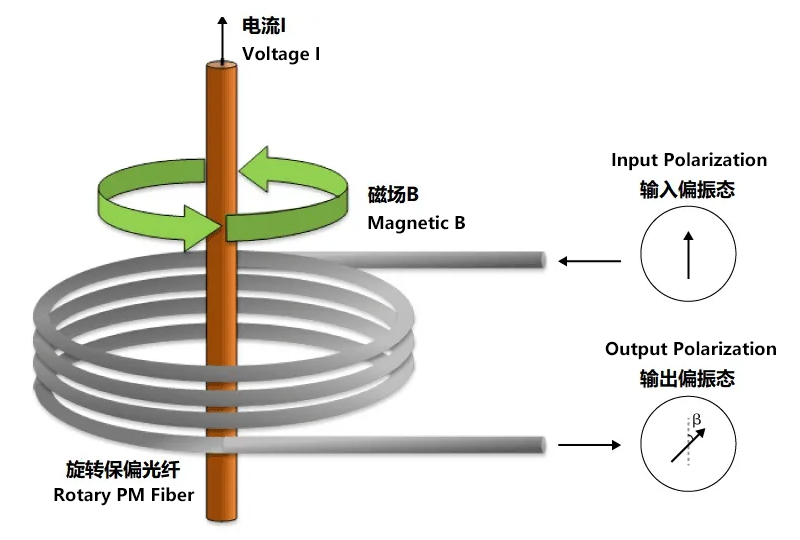
【Picture 4】 Operating Principle of Full Fiber Optic Current Transformer
Application 4: Integrated Optics
Integrated Optics is an important application of PM fiber. Lithium niobate (LiNbO3) modulators are typical integrated optics devices. The lithium niobate chip is diffused with a titanium dioxide-doped waveguide, and the pigtail of the bias-preserving fiber provides a stable polarization state and is aligned with the birefringence axis of the chip, as in [Image 5]. The functionality of the device is based on the Pockels effect: when a voltage is applied to the electrodes, the refractive index of the substrate changes in proportion to that voltage, and the eventual change in the effective optical range length can be used to generate interference, which, depending on the precise design of the titanium dioxide-doped waveguide, can be manipulated to provide phase, frequency or amplitude modulation, or even to switch optical power between channels.
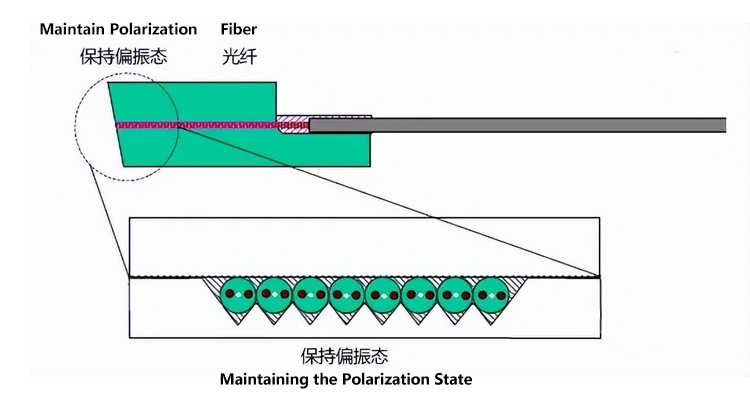
【Picture 5】PM fiber in integrated optics
Application 5: Fiber Optic Flow Sensor
PM fibers can also be used in various other types of fiber optic sensing systems. For example, Laser Doppler Velocimetry (LDV) for flow velocity measurement, as in [Image 6], determines the flow velocity of air flow or blood in a blood vessel by measuring the Doppler shift of light scattered by the fluid.
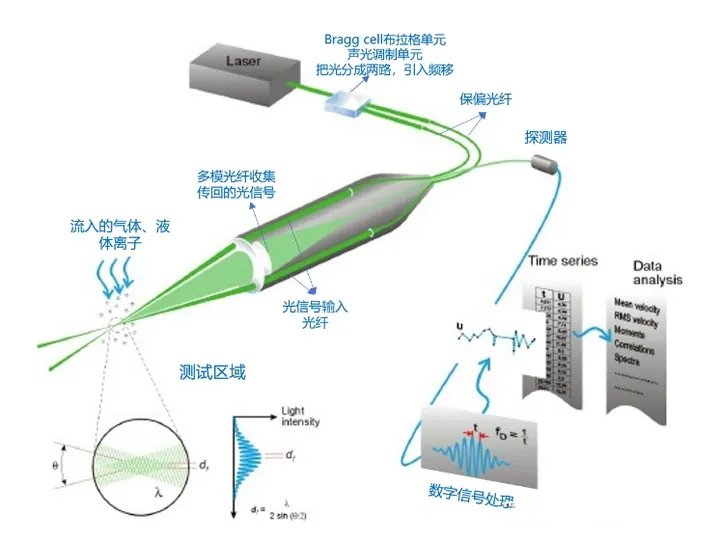
【Picture 6】Application of PM fiber in laser Doppler velocimetry
Application 6: Medical Applications
In medicine, doctors can diagnose patients with coronary heart disease with the help of a special catheter or “guidewire”, which is known as Optical Coherence Tomography (OCT) [Image 7]. OCT uses low-coherence (broadband) light, and a bias-preserving fiber plays an important role. OCT uses low-coherence (broadband) light, and PM fiber optics play an important role in this, allowing the surgeon to distinguish between the vessel wall and the blockage, thus facilitating further surgical treatment.
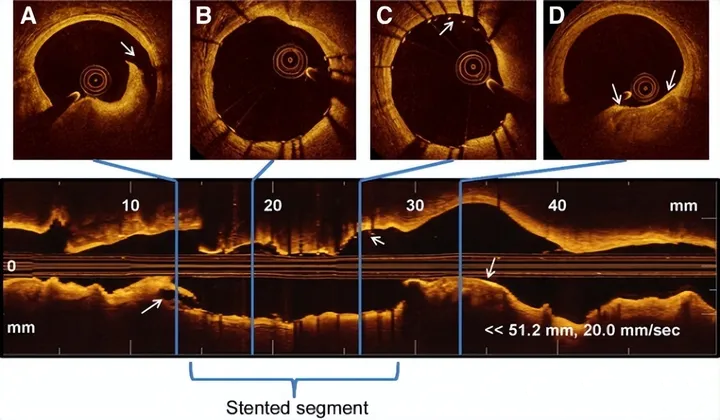
【Picture 7】Diagnostic OCT by catheterization in patients with chronic total obstruction of coronary arteries
Application 7: Substance Composition Testing
By using the characteristics of specific substances reacting with certain materials or adsorbing with each other, the bias-preserving optical fiber can also be used for the detection of the composition of substances, [Image 8]. Taking hydrogen detection as an example, the palladium metal layer (Pd layer) will absorb hydrogen and expand, which in turn will cause changes in the birefringence B of the adherent bias-preserving optical fiber, and by detecting this change, we can analyze whether the gas contains hydrogen and its content.
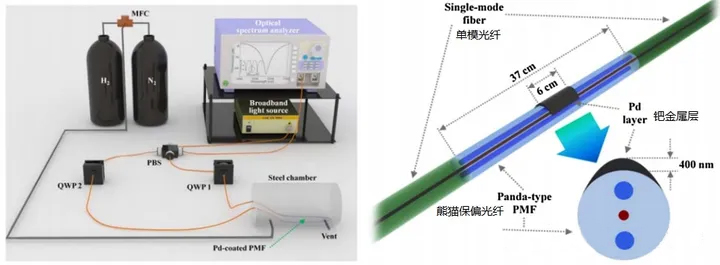
【Picture 8】Specific hydrogen detection system, and Panda PM fiber optic sensing unit with adhered palladium metal layer
Synthesize
Under the background of the rapid development of information technology such as digital economy, smart city and big data processing, the optoelectronics industry has entered into the fast lane, especially in recent years, the demand for all kinds of fiber optic sensing and Internet of Things applications has also shown explosive growth, which has made the core value of PM optical fiber more and more prominent. With the improvement of basic technology and manufacturing process of PM fiber, the fiber has become a functional “carrier”, combined with future applications, PM fiber technology will show functionality, matching and robustness.
Functionality: There are more and more applications for optical fibers with more than just a single bias preserving function: bias preserving optical fibers with large mode field area, gain PM optical fibers and bias preserving multi-core optical fibers, and so on;
Matchability: The customization of fiber OD size and coating materials to match the demanding conditions of multiple applications, such as fiber optic gyroscopy requiring fine diameters, aerospace needing anti-irradiation, and the laser industry needing rod-shaped fibers;
Robustness: optical fiber has been gradually applied to a number of scenarios, rich environmental conditions on the PM fiber robustness put forward higher requirements, that is, can not be affected by the environment or changes in the shape of the optical fiber itself, so there are such as high-strength, bending-resistant, temperature-insensitive, anti-irradiation, and other characteristics of the demand.
The technology iteration of the fiber itself will serve the development of the optoelectronics industry, the industry’s new requirements for the fiber technology to improve the formation of positive feedback. PM fiber is only a successful case of special optical fiber, we have reason to look forward to the special optical fiber industry has a better future.

